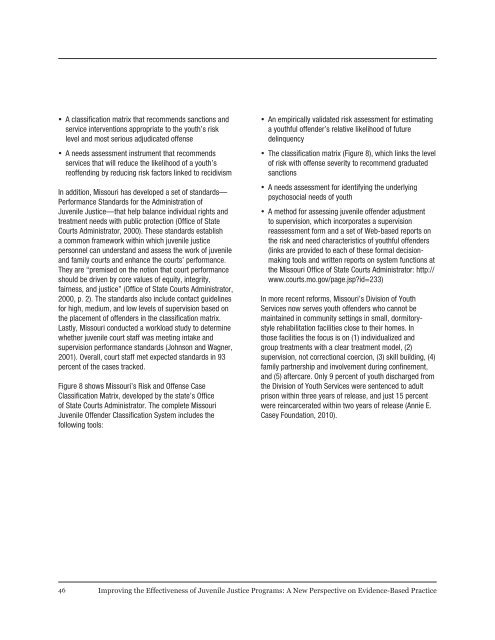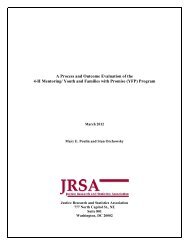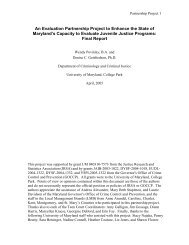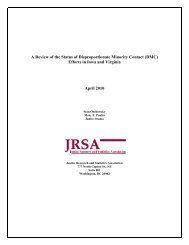Improving the Effectiveness of Juvenile Justice Programs: A New
Improving the Effectiveness of Juvenile Justice Programs: A New
Improving the Effectiveness of Juvenile Justice Programs: A New
You also want an ePaper? Increase the reach of your titles
YUMPU automatically turns print PDFs into web optimized ePapers that Google loves.
• A classification matrix that recommends sanctions and<br />
service interventions appropriate to <strong>the</strong> youth’s risk<br />
level and most serious adjudicated <strong>of</strong>fense<br />
• A needs assessment instrument that recommends<br />
services that will reduce <strong>the</strong> likelihood <strong>of</strong> a youth’s<br />
re<strong>of</strong>fending by reducing risk factors linked to recidivism<br />
In addition, Missouri has developed a set <strong>of</strong> standards—<br />
Performance Standards for <strong>the</strong> Administration <strong>of</strong><br />
<strong>Juvenile</strong> <strong>Justice</strong>—that help balance individual rights and<br />
treatment needs with public protection (Office <strong>of</strong> State<br />
Courts Administrator, 2000). These standards establish<br />
a common framework within which juvenile justice<br />
personnel can understand and assess <strong>the</strong> work <strong>of</strong> juvenile<br />
and family courts and enhance <strong>the</strong> courts’ performance.<br />
They are “premised on <strong>the</strong> notion that court performance<br />
should be driven by core values <strong>of</strong> equity, integrity,<br />
fairness, and justice” (Office <strong>of</strong> State Courts Administrator,<br />
2000, p. 2). The standards also include contact guidelines<br />
for high, medium, and low levels <strong>of</strong> supervision based on<br />
<strong>the</strong> placement <strong>of</strong> <strong>of</strong>fenders in <strong>the</strong> classification matrix.<br />
Lastly, Missouri conducted a workload study to determine<br />
whe<strong>the</strong>r juvenile court staff was meeting intake and<br />
supervision performance standards (Johnson and Wagner,<br />
2001). Overall, court staff met expected standards in 93<br />
percent <strong>of</strong> <strong>the</strong> cases tracked.<br />
Figure 8 shows Missouri’s Risk and Offense Case<br />
Classification Matrix, developed by <strong>the</strong> state’s Office<br />
<strong>of</strong> State Courts Administrator. The complete Missouri<br />
<strong>Juvenile</strong> Offender Classification System includes <strong>the</strong><br />
following tools:<br />
••<br />
An empirically validated risk assessment for estimating<br />
a youthful <strong>of</strong>fender’s relative likelihood <strong>of</strong> future<br />
delinquency<br />
••<br />
The classification matrix (Figure 8), which links <strong>the</strong> level<br />
<strong>of</strong> risk with <strong>of</strong>fense severity to recommend graduated<br />
sanctions<br />
••<br />
A needs assessment for identifying <strong>the</strong> underlying<br />
psychosocial needs <strong>of</strong> youth<br />
••<br />
A method for assessing juvenile <strong>of</strong>fender adjustment<br />
to supervision, which incorporates a supervision<br />
reassessment form and a set <strong>of</strong> Web-based reports on<br />
<strong>the</strong> risk and need characteristics <strong>of</strong> youthful <strong>of</strong>fenders<br />
(links are provided to each <strong>of</strong> <strong>the</strong>se formal decisionmaking<br />
tools and written reports on system functions at<br />
<strong>the</strong> Missouri Office <strong>of</strong> State Courts Administrator: http://<br />
www.courts.mo.gov/page.jsp?id=233)<br />
In more recent reforms, Missouri’s Division <strong>of</strong> Youth<br />
Services now serves youth <strong>of</strong>fenders who cannot be<br />
maintained in community settings in small, dormitorystyle<br />
rehabilitation facilities close to <strong>the</strong>ir homes. In<br />
those facilities <strong>the</strong> focus is on (1) individualized and<br />
group treatments with a clear treatment model, (2)<br />
supervision, not correctional coercion, (3) skill building, (4)<br />
family partnership and involvement during confinement,<br />
and (5) aftercare. Only 9 percent <strong>of</strong> youth discharged from<br />
<strong>the</strong> Division <strong>of</strong> Youth Services were sentenced to adult<br />
prison within three years <strong>of</strong> release, and just 15 percent<br />
were reincarcerated within two years <strong>of</strong> release (Annie E.<br />
Casey Foundation, 2010).<br />
46 <strong>Improving</strong> <strong>the</strong> <strong>Effectiveness</strong> <strong>of</strong> <strong>Juvenile</strong> <strong>Justice</strong> <strong>Programs</strong>: A <strong>New</strong> Perspective on Evidence-Based Practice

















